
The Agonoxeninae are a subfamily of moths.

The Sesiidae or clearwing moths are a diurnal moth family in the order Lepidoptera known for their Batesian mimicry in both appearance and behaviour of various Hymenoptera.
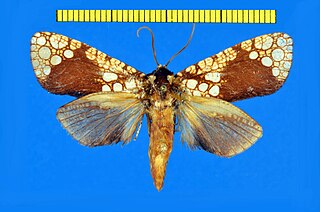
Dudgeonea is a small genus of moths and the only genus of its family, the Dudgeoneidae. It includes six species distributed sparsely across the Old World from Africa and Madagascar to Australia and New Guinea.
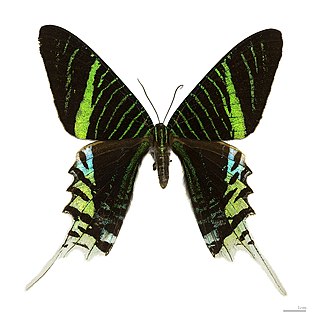
The Uraniidae are a family of moths containing four subfamilies, 90 genera, and roughly 700 species. The family is distributed throughout the tropics of the Americas, Africa and Indo-Australia. Some of the tropical species are known for their bright, butterfly-like colors and are called sunset moths. Such moths are apparently toxic and the bright colors are a warning to predators.
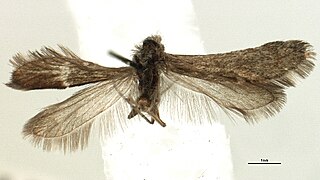
Heterobathmia is a genus of Lepidoptera. It is the only genus in the suborder Heterobathmiina, as well as in the superfamily Heterobathmioidea and in the family Heterobathmiidae. Primitive, day-flying, metallic moths confined to southern South America, the adults eat the pollen of Nothofagus or southern beech and the larvae mine the leaves. Most known species are undescribed.
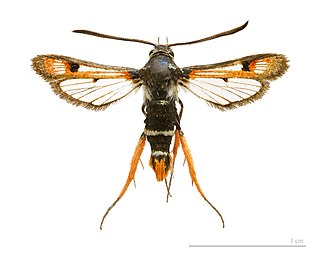
Sesioidea is a superfamily containing clearwing moths (Sesiidae), castniid moths (Castniidae) and little bear moths (Brachodidae). There is evidence from head and thoracic morphology that the first two families, internally feeding in plants as caterpillars, are sisters, whilst some brachodids are known to feed on leaf surfaces. Sesioidea is closely related to Cossoidea, which contains the also internal-feeding Goat and Leopard moths, and recent taxonomic treatments consider the sessoid families as part of Cossoidea sensu lato.
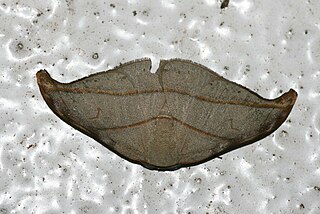
Drepanoidea is the superfamily of "hook tip moths". See Minet and Scoble (1999) for a comprehensive overview.

Lophocoronoidea is a superfamily of insects in the order Lepidoptera. There is a single extant genus, Lophocorona, in the family Lophocoronidae. These are small, primitive nocturnal moths restricted to Australia whose biology is largely unknown.

Cossoidea is the superfamily of moths that includes carpenter moths and relatives. Like their likely sister group Sesioidea they are internal feeders and have spiny pupae with moveable segments to allow them to extrude out of their exit holes in stems and trunks during emergence of the adult.
Coelolepida is a clade of insects in the lepidopteran order, containing the infraorders Acanthoctesia and Lophocoronina.
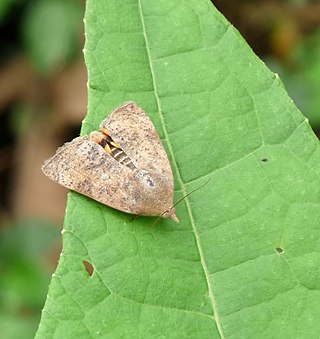
Hyblaeidae are the "teak moths", a family of insects in the Lepidopteran order. The two genera with about 18 species make up one of the two families of the Hyblaeoidea superfamily, which in the past has been included in the Pyraloidea. Recent phylogenetic studies find varying relationships of Hyblaeoidea among Ditrysian Lepidoptera: Mutanen et al. (2010) find the superfamily to group either with Pyraloidea, or – more often – with Thyridoidea or butterflies. The results of Wahlberg et al. (2013) and Heikilä et al. (2015) indicate a sister-group relationship with Pyraloidea.

Brachodidae is a family of day-flying moths, commonly known as little bear moths, which contains about 135 species distributed around much of the world. The relationships and status of the presently included genera are not well understood.

Carposinoidea, the "fruitworm moths", is a superfamily of insects in the lepidopteran order. The superfamily is also known as Copromorphoidea, which is a junior synonym. These moths are small to medium-sized and are broad-winged bearing some resemblance to the superfamilies Tortricoidea and Immoidea. The antennae are often "pectinate" especially in males, and many species of these well camouflaged moths bear raised tufts of scales on the wings and a specialised fringe of scales at the base of the hindwing sometimes in females only; there are a number of other structural characteristics. The position of this superfamily is not certain, but it has been placed in the natural group of "Apoditrysia" "Obtectomera", rather than with the superfamilies Alucitoidea or Epermenioidea within which it has sometimes previously been placed, on the grounds that shared larval and pupal characteristics of these groups have probably evolved independently. It has been suggested that the division into two families should be abandoned.
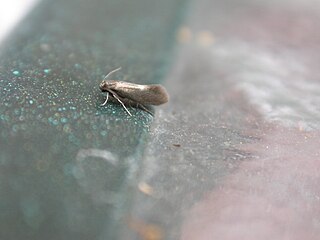
A family of primitive monotrysian moths in the order Lepidoptera, Heliozelidae are small, metallic day-flying moths with shiny smooth heads. In Europe the small adult moths are seldom noticed as they fly quite early in the spring. The larvae are leaf miners and the vacated leaf mines are distinctive because the larva leaves a large hole at the end.
The Palaeosetidae or miniature ghost moths are a family of insects in the order Lepidoptera contained within the superfamily Hepialoidea.

The Ratardinae are a small subfamily of large moths from Southeast Asia.
The Exoporia are a group of primitive Lepidoptera comprising the superfamilies Mnesarchaeoidea and Hepialoidea. They are a natural group or clade. Exoporia is the sister group of the lepidopteran infraorder Heteroneura. They are characterised by their unique female reproductive system which has an external groove between the ostium bursae and the ovipore by which the sperm is transferred to the egg rather than having the mating and egg-laying parts of the abdomen with a common opening (cloaca) as in other nonditrysian moths, or with separate openings linked internally by a "ductus seminalis" as in the Ditrysia. See Kristensen for other exoporian characteristics.

Heteroneura is a natural group in the insect order Lepidoptera that comprises over 99% of all butterflies and moths. This is the sister group of the infraorder Exoporia, and is characterised by wing venation which is not similar or homoneurous in both pairs of wings. Though basal groups within the Heteroneura cannot be identified with much confidence, one major subgroup is the leaf-mining Nepticuloidea. Species in this subgroup include some of the smallest lepidopterans identified.

The Antequerinae are a subfamily of the Cosmopterigidae. In the Nearctic, the subfamily consists of eight species in four genera, found in North America and England.
The Chrysopeleiinae are a subfamily of the Cosmopterigidae, although some authors treat it as a full family, the Chrysopeleiidae.
















